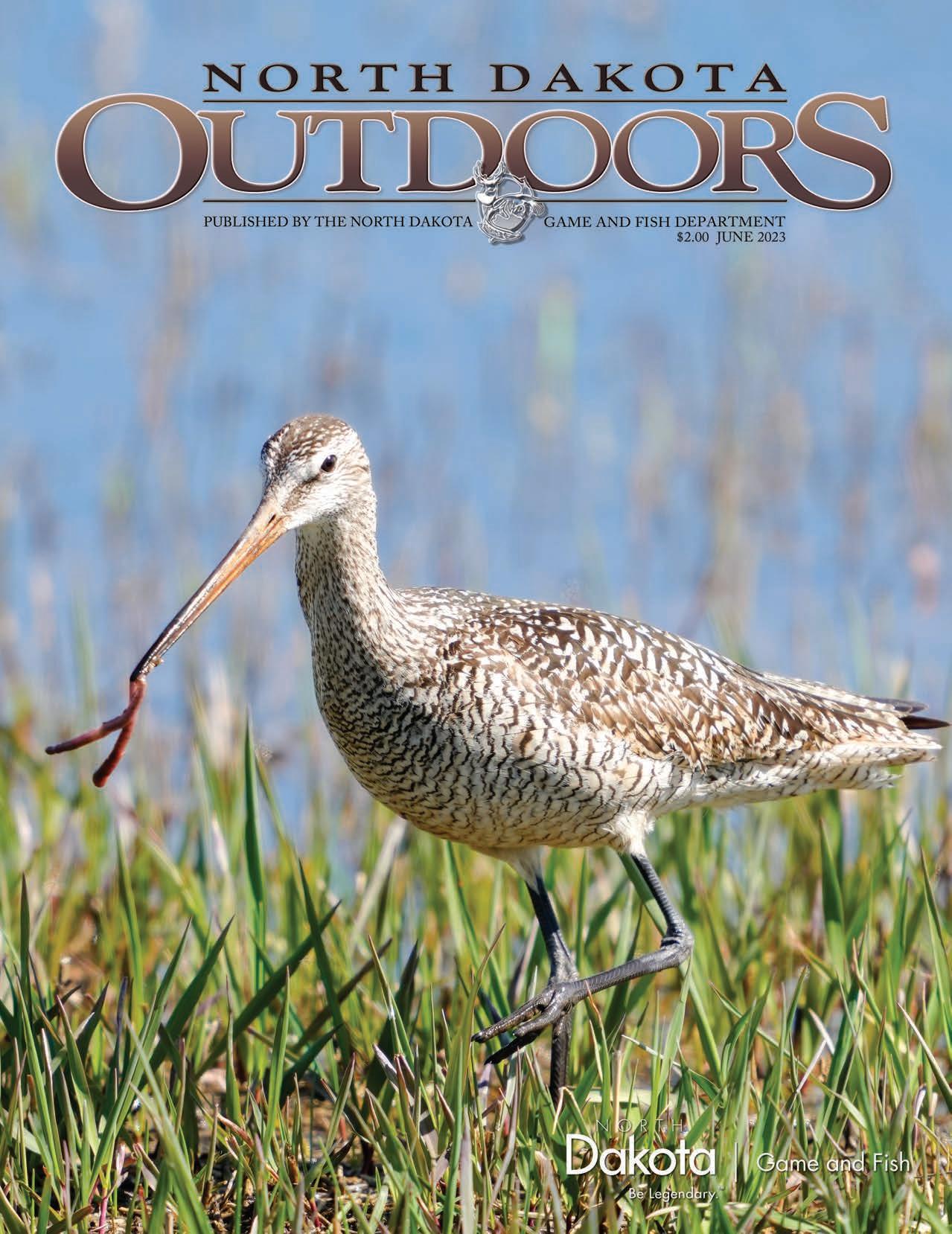
DEPARTMENT DIRECTORY
Governor Doug Burgum
ADMINISTRATIVE DIVISION
Game and Fish Director: Jeb Williams
Deputy Director: Scott Peterson
Chief, Administrative Services: Kim Kary
Federal Aid Manager: Corey Wentland
Administrative Staff Officer: Justin Mattson
Administrative Assistant: Lynn Timm
Building Maint. Supervisor: Brandon Diehl
Administrative Officer: Melissa Long, Alan Peterson
Accounting Manager: Angie Morrison
Accountants: Kelly Wike, Ashley Hillerson
Business Operations Manager: Brian Hosek
Technical Operations Lead: Alan Reile
Data Scientist: Shane Wegner
Licensing Manager: Randy Meissner
Assistants: Gail Mosset, Amanda Anstrom, Tracy Price, Tana Bentz, Tanya Mikkelsen
Administrative Assistant – Dickinson: Stephanie Richardson
Administrative Assistant – Devils Lake: Lisa Tofte
Administrative Assistant – Jamestown: Tonya Kukowski
Administrative Assistant – Riverdale: Mattea Bierman
Administrative Assistant – Williston: Nikki Wright
CONSERVATION AND COMMUNICATIONS DIVISION
Division Chief: Greg Link, Bismarck
Communications Supervisor: Greg Freeman, Bismarck
Editor: North Dakota OUTDOORS: Ron Wilson, Bismarck
R3 Coordinator: Cayla Bendel, Bismarck
Digital Media Editor: Lara Anderson, Bismarck
Video Project Supervisor: Mike Anderson, Bismarck
Photographer/Videographer: Ashley Peterson, Bismarck
Marketing Specialist: Jackie Ressler, Bismarck
Information Specialist: Dawn Jochim, Bismarck
Graphic Artist: Kristi Fast, Bismarck
Education Supervisor: Marty Egeland, Bismarck
Education Coordinator: Jeff Long, Bismarck
Hunter Education Coordinator: Brian Schaffer, Bismarck
Outreach Biologists: Doug Leier, West Fargo; Greg Gullickson, Minot; Jim Job, Grand Forks
Conservation Supervisor: Steve Dyke, Bismarck
Resource Biologists: John Schumacher, Bruce Kreft, Bismarck
Conservation Biologists: Sandra Johnson, Patrick Isakson, Elisha Mueller, Bismarck
Administrative Assistant: Amber Schroeter, Bismarck
ENFORCEMENT DIVISION
Division Chief: Scott Winkelman, Bismarck
Investigative Supervisor: Jim Burud, Kenmare
Operations Supervisor: Jackie Lundstrom, Bismarck
Warden Pilot: Jeff Sieger, Bismarck
Region No. 1 Warden Supvr: Mark Pollert, Jamestown
District Wardens: Corey Erck, Bismarck; Michael Sedlacek, Fargo; Andrew Dahlgren, Milnor; Erik Schmidt, Linton; Greg Hastings, Jamestown; Paige Swanson, Steele; Noah
Raitz, LaMoure: Gage Muench, Valley City
Region No. 2 Warden Supvr: Paul Freeman, Devils Lake
District Wardens: Jonathan Tofteland, Bottineau; Jonathan Peterson, Devils Lake; James Myhre, New Rockford; Blake Riewer, Grand Forks; Alan Howard, Cando; Peter Miley, Cavalier; Drew Johnson, Finley; Sam Feldmann, Rugby
Region No. 3 Warden Supvr: Doug Olson, Riverdale; Riley Gerding, Kenmare
District Wardens: Joe Lucas, Turtle Lake; Ken Skuza, Riverdale; Michael Raasakka, Stanley; Connor Folkers, Watford City; Shawn Sperling, Minot; Keenan Snyder, Williston, Josh Hedstrom: Tioga
Region No. 4 Warden Supvr: Dan Hoenke, Dickinson; Clayton Edstrom, Killdeer
District Wardens: Kylor Johnston, Hazen; Art Cox, Bowman; Courtney Sprenger, Elgin; Zane Manhart, Golva; Jerad Bluem, Mandan; Zachary Schuchard, Richardton
Administrative Assistant: Lori Kensington, Bismarck
WILDLIFE DIVISION
Division Chief: Casey Anderson, Bismarck
Assistant Division Chief: Bill Haase, Bismarck
Game Mgt. Section Leader: Stephanie Tucker, Bismarck
Pilot: Jeff Faught, Bismarck
Upland Game Mgt. Supvr: Jesse Kolar, Dickinson
Upland Game Mgt. Biologist: Rodney Gross, Bismarck
Migratory Game Bird Mgt. Supvr: Mike Szymanski, Bismarck
Migratory Game Bird Biologist: Andrew Dinges, Bismarck
Big Game Mgt. Supvr: Bruce Stillings, Dickinson
Big Game Mgt. Biologists: Bill Jensen, Bismarck; Brett Wiedmann, Dickinson; Jason Smith, Jamestown
Survey Coordinator: Chad Parent, Bismarck
Wildlife Veterinarian: Dr. Charlie Bahnson, Bismarck
Wildlife Health Biologist: Mason Ryckman, Bismarck
Game Management Biological Technician: Ryan Herigstad, Bismarck
Wildlife Resource Management Section Leader: Kent Luttschwager, Williston
Wildlife Resource Mgt. Supvrs: Brian Prince, Devils Lake; Brian Kietzman, Jamestown; Dan Halstead, Riverdale; Blake Schaan, Lonetree; Levi Jacobson, Bismarck
Wildlife Resource Mgt. Biologists: Randy Littlefield, Lonetree; Rodd Compson, Jamestown; Judd Jasmer, Dickinson; Todd Buckley, Williston; Jake Oster, Riverdale
Wildlife Biological Technicians: Tom Crutchfield, Jim Houston, Bismarck; Dan Morman, Robert Miller, Riverdale; Jason Rowell, Jamestown; Brandon Ramsey, Jace Brodzinski, Lonetree; Scott Olson, Devils Lake; Zach Eustice, Williston
Private Land Section Leader: Kevin Kading, Bismarck
Private Land Field Operation Supvrs: Nathan Harling, West Region; Curtis Francis, East Region, Bismarck
Private Land Biologists: Colin Penner, Bismarck; Jaden Honeyman, Ryan Oberhelman, Dickinson; Ryan Huber, Riverdale; Renae Schultz, Jamestown; Terry Oswald, Jr., Lonetree; Andrew Ahrens, Devils Lake; Jens Johnson, Bismarck; Erica Sevigny, Williston
Procurement Officer: Dale Repnow, Bismarck
Administrative Assistant: Alegra Powers, Bismarck
Lonetree Administrative Assistant: Diana Raugust, Harvey
FISHERIES DIVISION
Division Chief: Greg Power, Bismarck
Fisheries Mgt. Section Leader: Scott Gangl, Bismarck
Fisheries Supvrs: Russ Kinzler, Riverdale; Paul Bailey, Bismarck; Randy Hiltner, Devils Lake; Dave Fryda, Riverdale; Brandon Kratz, Jamestown
Fisheries Biologists: Todd Caspers, Devils Lake; Aaron Slominski, Williston; Mike Johnson, Jamestown; Jeff Merchant, Dickinson; Bryan Sea, Riverdale
Fisheries Biological Technicians: Phil Miller, Devils Lake; Pat John, Jamestown; Justen
Barstad, Bismarck; Brian Frohlich, Riverdale
Production/Development Section Supvr: Jerry Weigel, Bismarck
Aquatic Nuisance Species Coordinator: Benjamin Holen, Jamestown
Aquatic Nuisance Species Biologist: Grant Kapaun, Bismarck
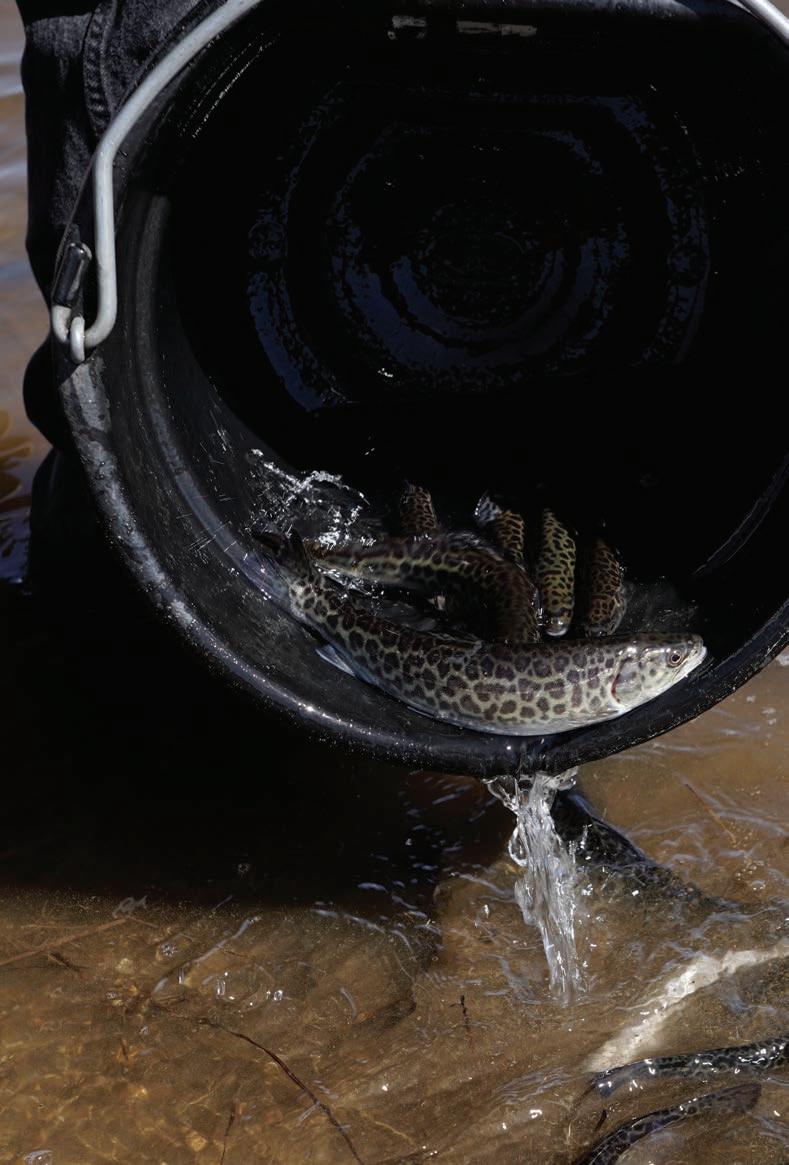
Fisheries Development Supvr: Bob Frohlich, Bismarck
Fisheries Dev. Proj. Mgr: Wesley Erdle, Bismarck
Fisheries Development Specialist: Kyle Hoge, Zach Kjos, Jacob Heyer, Bismarck
Administrative Assistant: Janice Vetter, Bismarck
ADVISORY BOARD
District 1 Beau Wisness, Keene
District 2 Travis Leier, Velva
District 3 Edward Dosch, Devils Lake
District 4 Bruce Ellertson, Michigan
District 5 Doug Madsen, Harwood
District 6 Cody Sand, Ashley
District 7 Jody Sommer, Mandan
District 8 Rob Brooks, Rhame
Contributing photographers for
Mike Anderson, Cayla Bendel, Jim Job, Sandra Johnson, Jesse Kolar, Ashley Peterson and Brian Schaffer
Periodical Postage Paid at Bismarck, ND 58501 and additional entry offices. Printed in the United States POSTMASTER: Send address changes to: North Dakota OUTDOORS 100 North Bismarck Expressway Bismarck, ND 58501-5095 Report All Poachers (RAP) 701-328-9921 In cooperation with North Dakota Wildlife Federation and North Dakota State Radio. Official publication of the North Dakota Game and Fish Department (ISSN 0029-2761) 100 N. Bismarck Expressway, Bismarck, ND 58501-5095 Website: gf.nd.gov • Email: ndgf@nd.gov • Information 701-328-6300 • Licensing 701-328-6335 • Administration 701-328-6305 • North Dakota Outdoors Subscriptions 701-328-6363 • Hunter Education 701-328-6615 • The TTY/TTD (Relay ND) number for the hearing or speech impaired is 800-366-6888
the
issue:
June
The mission of the North Dakota Game and Fish Department is to protect, conserve and enhance fish and wildlife populations and their habitats for sustained public consumptive and nonconsumptive use.

2 My 2 Cents
4 Rebounding From Winter
Earlier this spring, the Game and Fish Department acquired 5,000 tiger trout from Wyoming and stocked half in Fish Creek Dam in Morton County and the remainder in Hooker Lake in the Turtle Mountains. A cross between brook and brown trout, this is the first time tiger trout have been stocked in North Dakota.
8 Answering Curlew Questions
12 Toll of a Tough Winter
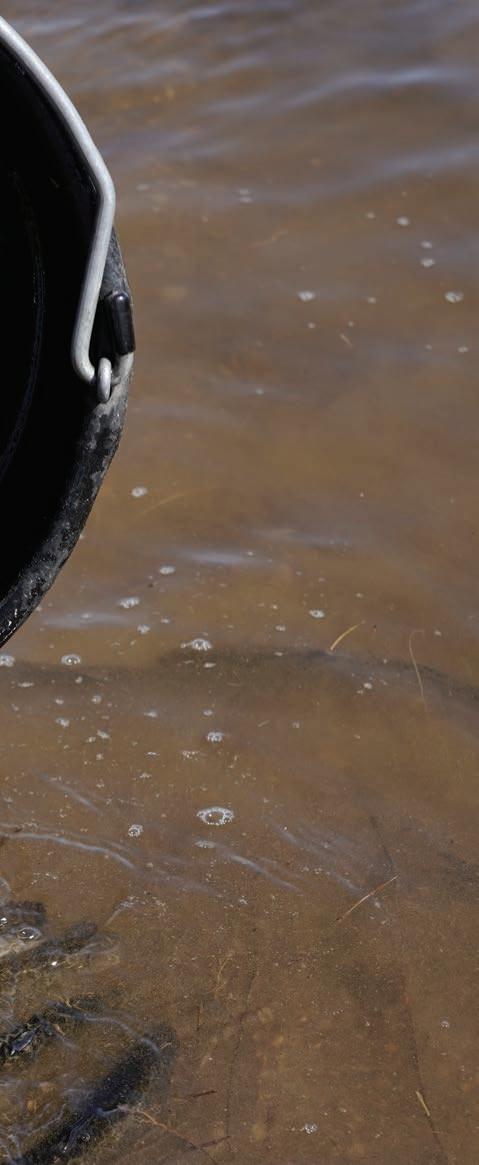
16 Helping Shape Management Decisions
20 Buffaloberry Patch
25 Back Cast
North Dakota OUTDOORS is published 10 times a year, monthly except for the months of April and September. Subscription rates are $10 for one year or $20 for three years. Group rates of $7 a year are available to organizations presenting 25 or more subscriptions. Remittance should be by check or money order payable to the North Dakota Game and Fish Department. Indicate if subscription is new or renewal. The numbers on the upper right corner of the mailing label indicate the date of the last issue a subscriber will receive unless the subscription is renewed.
Permission to reprint materials appearing in North Dakota OUTDOORS must be obtained from the author, artist or photographer. We encourage contributions; contact the editor for writer and photography guidelines prior to submission.
The NDGFD receives Federal financial assistance from the US Fish and Wildlife Service and the US Coast Guard. In accordance with Title VI of the Civil Rights Act of 1964, Section 504 of the Rehabilitation Act of 1973, Title II of the Americans with Disabilities Act of 1990, the Age Discrimination Act of 1975, and Title IX of the Education Amendments of 1972, the NDGFD joins the US Department of the Interior and its Bureaus and the US Department of Homeland Security in prohibiting discrimination on the basis of race, color, national origin, age, disability, sex (in education programs or activities) and also religion. If you believe you have been discriminated against in any program, activity, or facility as described above, or you desire further information, please write to: ND Game and Fish Department, Attn: Chief of Administrative Services, 100 N. Bismarck Expressway, Bismarck, ND 58501-5095 or to: Office of Civil Rights, Department of the Interior, 1849 C Street, NW, Washington, DC 20240.
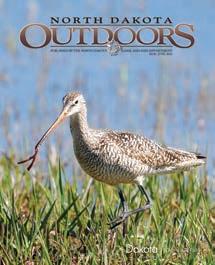
JUNE 2023 • NUMBER 10 • VOLUME LXXXV ■ Editor: Ron Wilson ■ Graphic Designer: Kristi Fast ■ Circulation Manager: Dawn Jochim
Front Cover The marbled godwit, about crow-sized, is one of the largest shorebirds. Photo by Ashley Peterson.
CONTENTS
My 2 Cents
By Jeb Williams, Director

The quick transition from winter to spring to summer is in motion once again here in North Dakota. While most of us were more than ready to shift from winter to spring, the spring to summer change didn’t come quite as easily to those of us who seem to navigate a bit better with daytime highs not going too much above 65 degrees.
With the transition of seasons comes the data collection that is a critical driver to the mission of our agency. How did deer get through the winter? How about our upland game birds? How successful was the fawning period for pronghorn? How significant was the winterkill in many suspect lakes?

And so it goes.
Answering all these questions is something the Department does each year as our seasons change and those fish and wildlife resources face different challenges here in our neck of the Northern Plains. Countless hours of staff time was spent in a snug Super Cub counting big game from the air, breaking through thin sheets of ice in search of walleye and pike eggs, not to mention the folks who put in lot of gravel time during their travels returning to annual upland game monitoring sites to keep our longstanding commitment to the public … a data-driven approach to make the best decisions possible benefitting current and future populations.
It appears that we are once again off to a great start across the state as fishing success has been terrific. Moisture has been above average in many areas, meaning grassland and wetland conditions are off to a great start and increasing the odds of successful reproduction for our upland and waterfowl species. With good moisture usually comes a diversity of insects that, while sometimes annoying, provide a valuable food source for pheasant broods their first five weeks of existence. Understanding this, we can handle this nuisance knowing that it will translate well to our fall hunting pursuits.
In the interim, have a safe summer.
2 ■ ND OUTDOORS ■ JUNE 2023




FE B ATING Life jackets save lives For more boat safety tips, visit our website gf.nd.gov/education BOATING IS SERIOUS FUN

4 ■ ND OUTDOORS ■ JUNE 2023
The fallout of a tough winter at Goose Lake
in Emmons County.
REBOUNDING REBOUNDING REBOUNDING from winter
By Ron Wilson
Some fish die every winter. It happens.
Even so, last winter was a different story. Snow came early and often and seemingly hung around forever, blocking sunlight from penetrating the ice and handcuffing underwater plants from producing oxygen fish need to survive.
The fallout, it is suspected, that more lakes than typical suffered winterkill.
A lot more.
North Dakota Game and Fish Department fisheries biologists took dissolved oxygen level readings on many lakes in the dead of winter and the findings were, not surprisingly, discouraging.

“I think our guys compiled a list that probably included 80 or 90 lakes that had concerning oxygen levels,” said Scott Gangl, Department fisheries management section leader, in early May when some lakes around the state were still iced over and had yet to reveal the outcome of the long winter. “And by concerning, it means it may not be 100% lethal, but with a lot of winter remaining, there was probably going to be a drop to lethal levels. Some of the lakes were already dead when they were tested in February.”
Yet, not all the lakes on the too-long list will likely suffer total winterkill. Some may suffer some mortality, but still pull through.
“Out of that list of lakes, I bet there’s maybe a half a dozen that were good quality lakes that don’t usually winterkill. Some of the others are marginal lakes that are kind of susceptible to winterkill from time to time anyway,” Gangl said. “Some will winterkill every few years, some will winterkill occasionally. There really aren’t a lot of surprises on the list. It’s just that this winter triggered all of them to be low all at once because of the long-term snowpack and ice cover.”
ND OUTDOORS ■ JUNE 2023 ■ 5
While some of the lakes had low enough dissolved oxygen levels to kill fish, there’s a chance not everything in the lakes will die and what remains can pose management problems.
“What you end up with is some of the sensitive species, which tend to be game fish or desirable fish to anglers, are the ones that are going to be impacted. Often, the survivors are the tougher species, which tend to be the nongame fish like bullheads, carp and suckers,” Gangl said. “And so, you end up with a situation where they’re now allowed to thrive in this open environment, while we’re trying to establish game fish back into a lake. That’s why we do have some problems with bullheads and other rough fish in some of parts of the state.”
Gangl said that while it’s a setback to lose dozens of lakes to winterkill, but not surprising considering the magnitude of the winter, fisheries managers are prepared to deal with the aftermath.
“Again, the vast majority of the lakes that we’re monitoring have winterkilled in the past, and a lot of them are already on our stocking request because we stock them annually,” he said. “We’re going to lose some lakes, but if you can start over with a clean slate and get a complete kill on some of these places, we’re able to restock. We’ll get fish in there as soon as we can.”
Not all of the fish will come from the hatchery to
reboot winterkill lakes. Gangl said Department fisheries personnel will trap adult fish in one lake and transport them to another.
“What we’ve found is that if you have a situation where you don’t have fish in a lake, call it a barren lake, we can stock pre-spawn fish like yellow perch, bluegills and crappies,” Gangl said. “If it’s something that’ll reproduce, it doesn’t take very many parents to produce a year-class in a situation where there’s no other fish in there to compete with or to eat the young-of-the-year, so they’ll take off pretty quickly.”
Gangl said it could take fisheries biologists weeks in some cases to assess the damage. Due to the late start to spring, and the significant effort required to spawn northern pike and walleye right

To jumpstart winterkilled lakes, fisheries personnel don’t rely totally on fish from the hatchery. Instead, crews spent part of spring trapping fish (yellow perch in these photos) in one lake and transporting to another impacted by a long winter.


6 ■ ND OUTDOORS ■ JUNE 2023
after ice-out, getting to many of these lakes will take time.
“Our crews are so busy at this time of year, and it’s compressed in such a short amount of time. I know that there have been a handful of winterkill assessments, but on a year like this, I don’t expect most of the information to be collected until well into summer,” he said. “Again, because many of these lakes were already scheduled to be stocked, we’ll likely go ahead and do that.
“When we do our standard fish sampling from the end of May into July is when a lot of these assessments are probably going to happen this year just because of the time factor,” he added. “We just won’t have time to get to all of them right away. But over the course of summer, we’ll get to
them when we normally would sample them and just to see what’s left.”
If every fishery on the winterkill lake is toast, and that’s not likely, the fishing outlook remains solid, considering that North Dakota harbors a record number of waters.



“Even if we lost all of the waters that we were concerned about, we’d still have more lakes than we had 20 years ago,” Gangl said. “A lot of those lakes are going to have really good fishing opportunities. And some of the lakes that are on our list of concern are still going to have good fishing opportunities because they’re not going to be complete winterkills.”
And those waters that will need some help from stocking and the transportation of adult fish will be back online in a few short years, Gangl said.
“One of the nice things about living in North Dakota is that our lakes are very productive, and fish grow really fast in many of them,” he said. “Also, with the snowpack, with the long winter, we didn’t see as much runoff as we kind of expected. But there was some and I think some of these lakes got maybe a little shot of water or at least the aquifers were recharged. And that will help with productivity and growth.”
ND OUTDOORS ■ JUNE 2023 ■ 7
RON WILSON is editor of North Dakota OUTDOORS.
Sandra Johnson
and Jay
search for nesting long-billed curlews in southwestern
Dakota. While long-billed curlews are North America’s largest shorebird, they can be difficult to spot even in the seemingly

8 ■ ND OUTDOORS ■ JUNE 2023
(left)
Carlisle
North
wide open of this neck of North Dakota.
Answering Curlew AnsweringQuestions? Curlew Questions
By Ron Wilson
It’s interesting. No, scratch that. It’s amazing that male and female long-billed curlew pairs that wintered months and miles apart in places like Texas and Mexico, rendezvoused in southwestern North Dakota to nest and raise young, in some instances in the same darn field, just like they did last year.
We know this because researchers from Boise State University’s Intermountain Bird Observatory and Northern Great Plains Program of American Bird Conservancy captured and fit GPS and satellite transmitters on five birds in 2022 to better understand the habitat use of this large shorebird in southwestern North Dakota and elsewhere.
From the time the curlews were fitted with tracking devices in the North Dakota Game and Fish Department funded research program, researchers were provided updates on the whereabouts of the birds on their computers daily, or in some instances, every few hours.
“Of the North Dakota birds, three migrated to the Laguna Madre ecosystem down to the border between Texas and Mexico. One went offline pretty quickly, so we think it was a transmitter failure issue,” said Jay Carlisle, research director with Intermountain Bird Observatory. “But two wintered either side of the border in Texas and Mexico, and then two others went to the interior of Mexico and Durango, and they stayed for a while and then they both moved to other areas. One went to the west coast of

?
ND OUTDOORS ■ JUNE 2023 ■ 9
Mexico, and one went further south in interior Mexico.”
Researchers gathered in southwestern North Dakota again earlier this spring to deploy transmitters on anywhere from four to seven more curlews to add more feathered bodies to the study.
Sandra Johnson, Game and Fish Department conservation biologist, said the Department’s role is to provide funding for the project.
“That funding is from the nongame fund, the Watchable Wildlife Tax Checkoff Fund,” she said. “So, the project is really funded by those people who donate to that account.”
Long-billed curlews are on North Dakota’s Species of Conservation Priority list as their population has declined in the state over time.
“The information we’re getting from the birds with transmitters is important for managing the species now, but even into the future so that we can keep monitoring the population, tracking how they’re doing over time,” Johnson said. “Maybe curlew range will increase with some of these great opportunities out there for landowners working with these partners to do things on their land that increases the health of the grasslands while keeping ranching on the landscape. That’s really important to these birds and North Dakota.”
Researchers are not only interested in where the birds spend winter, but also important migration
routes and potential stopover areas. The curlews fitted with transmitters in 2022 showed that they stopped in Kansas and other states on the southern Great Plains between North Dakota and Texas.
“It was really interesting how one curlew in particular just really hung out kind of in the city limits in a city in Texas and was going to different parks and soccer fields. And then you’ve got another curlew that just went right to the beach, the ocean, and stayed there all winter long,” Johnson said. “But then on the way back to North Dakota in spring, it was interesting how most of them stopped in Kansas. That was interesting to see because that wasn’t a place that they stopped on the way south, but that was a really important place for them coming back to the breeding grounds to get ready for the nesting season up here.”
Just as significant as wintering grounds and stopover sites, is the nesting habitat in southwestern North Dakota.
“In the bird world we always talk about North Dakota as the Duck Factory. And, obviously, this is the grassland bird factory as well. There’s nowhere else making more of these birds, which is why it’s so important here because it’s kind of the source,” said Kevin Ellison, program manager for Northern Great Plains Program. “In wildlife populations there’s mortality occurring throughout the year, particularly in the young-of-the-year, so you need the source to maintain the population.
“And then the hard part is when there’s mortality along the way, and we do see changes on the landscape that in some instances could be drastic,” he added. “So, it’s just a lot of stress on these birds to find suitable habitat. And then if you think about changes throughout the migration, that’s kind of almost like 100 paper cuts. It’s just stress all along the way if they have to try and land somewhere midway in Kansas or Nebraska and there might have been a change in the land use in that area, which would be stressful for them to try and find cover to be protected from predators.”
To trap and fit adult nesting long-billed curlews with GPS and satellite technology in southwestern North Dakota, Ellison said researchers work closely with landowners, which entails working hard at maintaining those relationships.

 Jay Carlisle (left) and Kevin Ellison carefully remove an adult long-billed curlew from the 18-meter mist nest used to capture nesting birds.
Jay Carlisle (left) and Kevin Ellison carefully remove an adult long-billed curlew from the 18-meter mist nest used to capture nesting birds.
10 ■ ND OUTDOORS ■ JUNE 2023
“It’s great working with a lot of North Dakota landowners because they are proud stewards of the land and interested and curious about what they have on their land and what the birds might be doing on their land and even when they leave,” Ellison said. “If you think about it, the curlews are only here for maybe two or three months, but we still think of them as our birds, even when they’re down somewhere south for most of the year.
“I think really the point of pride in stewardship is looking at these intact landscapes that maintain these species and realizing that it’s a part of the whole system,” he added. “We have a saying ‘what’s good for the bird is good for the herd.’ So, a lot of holistic managers are getting into that kind of thinking and more and more people are looking at birds as indicators of range health. And then that’s going to tie into economic health of their operations.”
While it’s never easy capturing nesting curlews with an 18-meter mist net carried parallel to the ground, birds in some instances were at least easier to locate because of the GPS and satellite transmitters.
“What’s pretty cool is that these birds are basically, almost exactly, back on their same territory,” Carlisle said of the birds nesting in 2023. “We’ve actually found nests of two of the individuals and one is about 500 yards to the east of where she nested last year. Another one is maybe 300 meters east of where he was last year. Very similar territories. So, basically right back to the same home.”
Johnson said researchers will continue to monitor the curlews fitted with tracking devices this year and into the next.


“I guess we’ll see if we want to continue the project and capture more birds or maybe we’ll find other opportunities to work with these partners on other grassland birds,” she said. “There are lots of grassland birds that we need to learn more about so that we can help protect those populations.
“All this habitat is really important to these birds, but it’s also important to the people who live out here,” Johnson added. “These are some beautiful grasslands here in western North Dakota. So, if you haven’t been out here, it’s just beautiful being outside and listening to the birds and working with some great people. We couldn’t do this without permission of the landowners.”
Curlew Wanderings
Some examples of the comings and goings of long-billed curlews captured and fitted with GPS and satellite transmitters in North Dakota in 2022.
Male 6A – Left North Dakota on July 4, 2022, stopped in Nebraska from July 5-7, then flew directly to Laguna Madre, Mexico and hung out at a hypersaline coastal lagoon from July 9, 2022 to March 27, 2023. He left March 28, 2023, and made a spring stopover south of Garden City, Kan., from March 31 to April 16. On April 17, he arrived back at the field in North Dakota where he was tagged.
Female 6J – Left North Dakota on July 5, 2022, flew over the Black Hills, took a brief rest in western Nebraska and then in southwest Texas from July 7 to July 12. On July 12, she left Texas and flew to the Laguna Santiaguillo in Durango, Mexico, a significant wetland ecosystem that provides wintering habitat for large numbers of waterbirds. She stayed until November 3 and then went southwest to near the Pacific Coast near Mazatlan. On April 3, 2023, she headed north and made a spring stopover southwest of Lubbock, Texas until April 11. That evening, she made a direct flight to North Dakota and arrived 24 hours later in the field where she was tagged.
Female 6H – Left North Dakota on June 14, 2022. Except for a 15-hour stopover in central Kansas and a couple other short breaks, she flew almost 1,500 miles nonstop until June 19 when she arrived at Laguna Atascosa National Wildlife Refuge near the Texas coast, but the transmitter may have failed because researchers have not heard from her since.
RON WILSON is editor of North Dakota OUTDOORS.
ND OUTDOORS ■ JUNE 2023 ■ 11
Tollof a
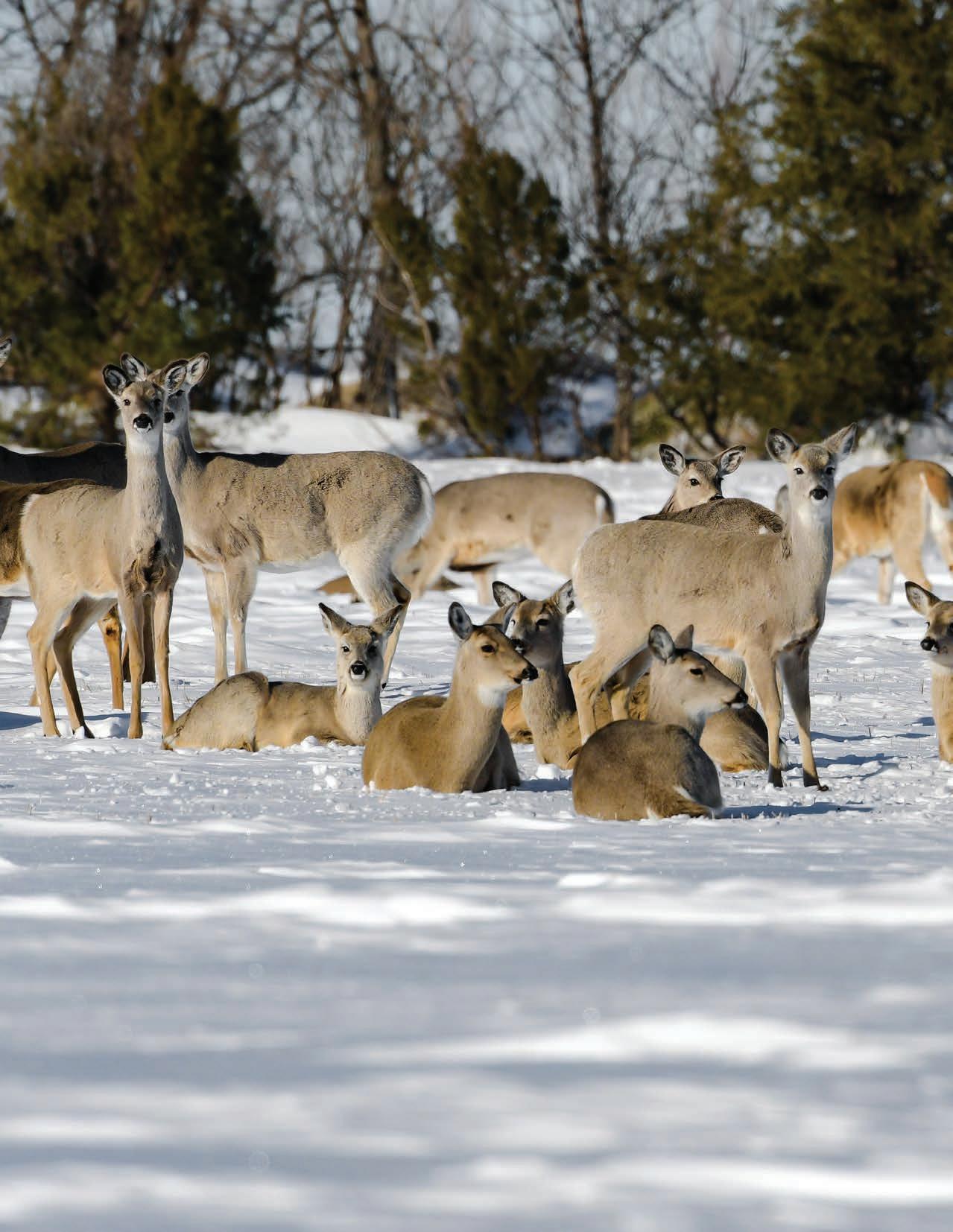
12 ■ ND OUTDOORS ■ JUNE 2023
tough
winter
 By Ron Wilson
By Ron Wilson
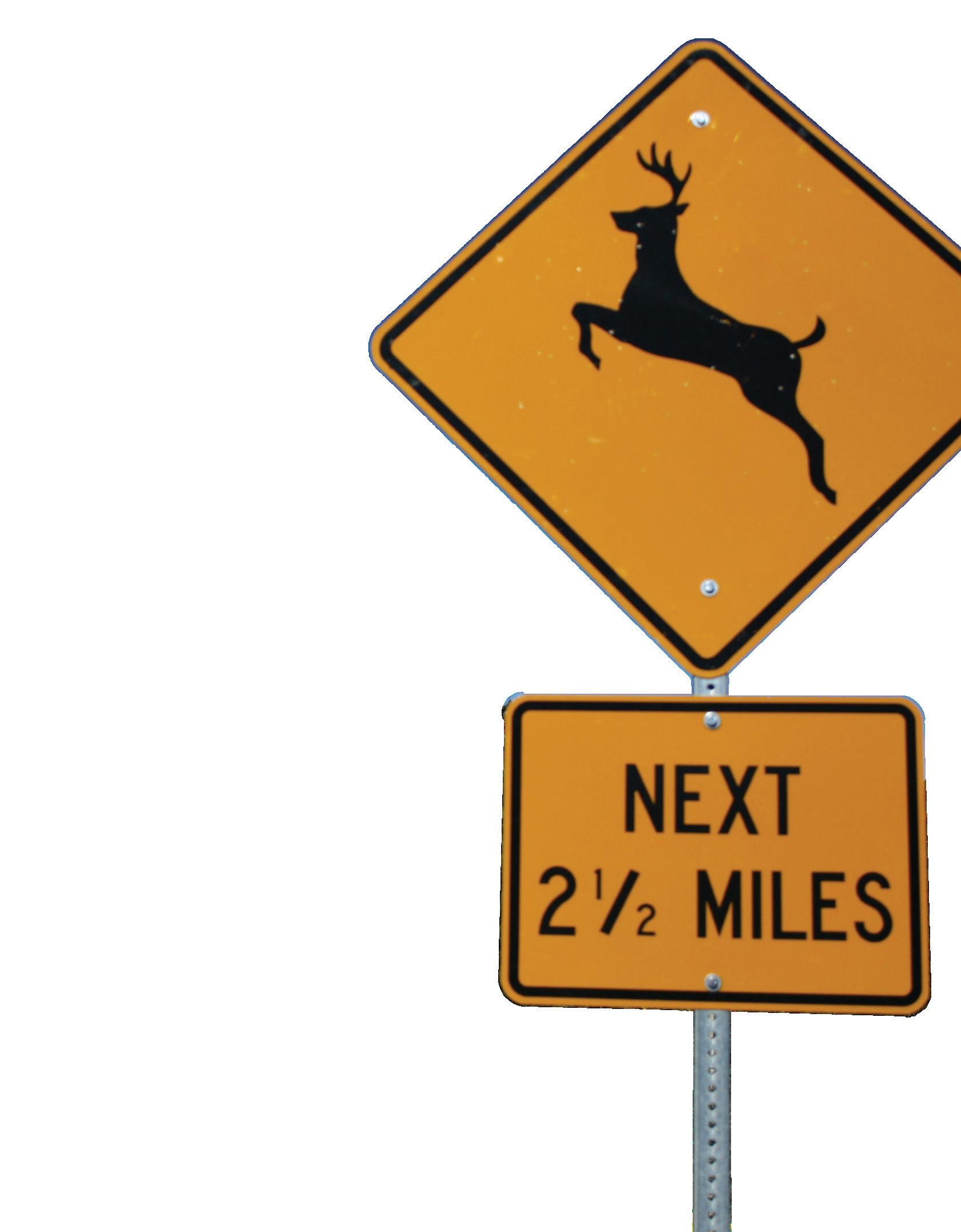
ND OUTDOORS ■ JUNE 2023 ■ 13
While
State wildlife managers made available 53,400 deer gun licenses for 2023, nearly 11,000 fewer than 2022, making it the lowest tag total since 2016.
While this is not the kind of news hunters wanted to hear, the announcement made by North Dakota Game and Fish Department officials weeks prior to the June 7 lottery deadline came as no surprise following an ugly winter that hung around for half a year.
An untold number of deer died last winter from starvation or exposure as much of what little quality winter

habitat there is on the landscape was uninhabitable because of all the snow. While there were reports of winterkilled deer across the state, some of the hardest hit areas extended from Bismarck east and south.
Casey Anderson, Game and Fish Department wildlife division chief, said some deer went into winter not in the best shape and didn’t stand much of a chance against a winter that showed up in early November and refused to give in to spring.
“Everything compounds itself when you talk about wildlife. Think back a couple of years when we had back-to-back years of pretty bad drought that we finally came out of last year about halfway through summer that was tough on animals,” Anderson said. “To really build up those fat reserves and things that carry an animal through winter, it takes exceptional habitat to do that, which we didn’t have.”
Wildlife managers rely on a host of things to determine the number of deer licenses to make available to hunters including, but not limited to, what game wardens and other staff are seeing in the field in winter, hunter harvest surveys and aerial surveys.

With plenty of snow on the landscape – 12 inches is needed to fly the surveys – Game and Fish personnel spent 251 hours in the air, starting in early January, counting deer over all survey areas encompassing 27% of the state. Observers also drove nearly 17,000 miles last winter to meet the pilots before ever going into the air.
“It was a long year to put it bluntly,” said Jason Smith, Department big game management biologist, Jamestown. “An airplane is a great office to have and provides a great view of the state, but it can get rigorous.”
Ideally, it’s best to fly when it’s not minus 30 and windy, but considering it’s the Northern Plains, you’d have to imagine that it’s seldom ideal.
Pilots fly at altitudes of 250-350 feet at speeds below 80 mph. Observers count all deer, but don’t classify them as buck, doe or fawn.
Smith said what they observed from
Winter came early in North Dakota and hung around until early April in most parts of the state, killing an untold number of deer during its long, unwanted stay.
14 ■ ND OUTDOORS ■ JUNE 2023
the opening weekend of deer season was windy, but open, hunters had to deal with plenty of snow for the remainder of the season.
their aerial offices over 6-plus weeks of survey time was discouraging. For example, they saw a 51% decrease in white-tailed deer and an 84% decrease in mule deer in the WingTuttle area (hunting units 2J1 and 2J2) from Jan. 10 to April 7.
While Smith said big game biologists can’t discount that deer in the Wing-Tuttle area didn’t just move from Jan. 10 to April 7, swaying the large decline in deer tallied, it’s highly unlikely that’s what happened.
“When we do these surveys, we take waypoints so we can go back and see where these groups of deer were at,” he said. “And the reality of it is if they didn’t go anywhere from November to January, they definitely didn’t go anywhere from January to that April time frame, just based on the conditions on the ground.”
When Department personnel flew the last survey in early April in the Wing-Tuttle area, Smith said some of the deer were dead and just didn’t know it yet.
“Even in January, they were a lot livelier. While we were not chasing deer by any means, the airplane is loud when you’re surveying and the deer move around,” Smith said. “The flight in April, they wouldn’t even get out of their beds. They would lay there and if they are upright, you could tell they weren’t doing good. And that kind of carried over to the number of deer reported dead or dying or starving.”
As difficult as something like this is
to watch, Smith said with little quality winter wildlife habitat on the landscape, the reality, especially during a winter like the last, is oftentimes staggering.
“There are multiple generations of North Dakotans that don’t have any idea it was a rarity at one time in North Dakota to see a whitetail deer outside of your traditional riparian areas. Not that long ago if you saw a whitetail running around, it was something you told your neighbor,” Smith said. “We’ve got to remember that we are on the Northern Plains and winter at times can be a pretty big equalizer no matter what we do. We’re lucky to have deer where we have them, but it’s not surprising that they run into the struggles that they do.”
The direct losses from winter –many dead deer on the landscape – was one thing. It’s the multiyear impact that’s not often thought about that will influence the deer population down the road.

“In a winter like we just had, generally what you lose first are the youngof-the-year and then reproduction. So, you’re losing that recruitment cohort and then you’re probably going to lose some of the reproduction side of things because those does are in poor health, aren’t going to probably carry fawns to full term,” Smith said. “And then, depending on how our summer season goes, if we head right into a drought, what’s their condition going to be like going into the breeding season?”
Anderson said it’s going to take more than a kind hand from Mother Nature next winter to help in the rebound of whitetails over much of the state and mule deer in western North Dakota.
“It’s going to take habitat on the landscape. It was pretty evident this winter where it was and where it wasn’t,” Anderson said. “But also, if you don’t have fawning habitat you don’t raise any fawns to take over. So, even if Mother Nature helps us out and we get easy winters, but it’s a struggle for deer to raise fawns because they can’t hide them and they’re getting predated, it’s not going to speed anything up.”
While it’s uncertain what tomorrow will bring, Smith said the one good thing is that winter, the likes of which we haven’t experienced in years, is behind us.
“We get a lot of help from people in the Department when it comes to aerial surveys, but it comes down to four big game biologists for the whole state of North Dakota trying to manage deer, trying to keep deer on the landscape to provide hunting opportunities,” he said. “And then you get a winter like this that comes along, and you come back into the Jamestown yard and see people unloading all these dead deer that they’ve picked up, and it’s just like ‘man alive.’”
RON WILSON is editor of North Dakota OUTDOORS.
ND OUTDOORS ■ JUNE 2023 ■ 15
Mule deer seen during the Department’s aerial survey last winter.
MANAGEMENT DECISIONS SHAPE HELPING
By Greg Power
Public input is critical in guiding the North Dakota Game and Fish Department with work activities and priorities. This input comes in many forms, ranging from face-to-face meetings, phone calls, emails, the list goes on. Another avenue that provides valuable input is the Department’s periodic angler preference/opinion surveys that are helpful in garnering additional input and better insight from the fishing public. These surveys date back to 1965 and are conducted about once every 3-8 years.
This past winter a survey (both electronic and mail) was sent to nearly 7,000 resident anglers licensed in 2022-23. The results are invaluable to the Department and, as always, will be used as part of the thought process in decision making. What follows are graphs (2023 information), trends and narrative explaining the usefulness of this information. Also note that these are just a few examples of the questions asked and angler responses.

16 ■ ND OUTDOORS ■ JUNE 2023

ND OUTDOORS ■ JUNE 2023 ■ 17
Zebra mussels along the shore of the Red River.
What is your perspective regarding the number of fishing/boating facilities (e.g., boat ramps, docks, etc.) at North Dakota fishing waters?
What is your perspective regarding the number of fishing/boating facilities (e.g., boat ramps, docks, etc.) at North Dakota fishing waters?
Boating access facilities are important to many, especially as North Dakota surpassed the 70,000 mark in terms of licensed motorized watercraft in our state. Knowing the wants and needs of the fishing and boating public helps the Department plan accordingly for boating access in the years to come.
Boating access facilities are important to many, especially as North Dakota surpassed the 70,000 mark in terms of licensed motorized watercraft in our state. Knowing the wants and needs of the fishing and boating public helps the Department plan accordingly for boating-access in the years to come.
Which types of fishing did you participate in last year in North Dakota?
Which types of fishing did you participate in last year in North Dakota?
This information is insightful for the Department to better understand the fishing community and what all types of fishing they participate in. Similar or identical questions are asked approximately once every five years which helps the Department follow trends in fishing.
Do you prefer fishing regulations (e.g., season length, limits, methods, bait restrictions, etc.) that are more complex but lake specific, or simple but statewide?
This information is insightful for the Department to better understand the fishing community and what all types of fishing they participate in. Similar or identical questions are asked approximately once every five years which helps the Department follow trends in fishing.
Do you prefer fishing regulations (e.g. season length, limits, methods, bait restrictions, etc.) that are more complex but lake specific, or simple but statewide?
Do you prefer fishing regulations (e.g., season length, limits, methods, bait restrictions, etc.) that are more complex but lake specific, or simple but statewide?
Tracking angler desires in terms of a regulation framework is ultimately critical in obtaining full compliance of existing regulations. As has been the case for years, North Dakota anglers have expressed strong support for simple fishing regulations.
Tracking angler desires in terms of a regulation framework is ultimately critical in obtaining full compliance of existing regulations. As has been the case for years, North Dakota anglers have expressed strong support for simple fishing regulations.
Tracking angler desires in terms of a regulation framework is ultimately critical in obtaining full compliance of existing regulations. As has been the case for years, North Dakota anglers like fishing regulations that are simple and straightforward.
What is your opinion of the North Dakota fishing regulations (season length, limits, methods, bait restrictions, etc.)?
What is your opinion of the North Dakota fishing regulations (season length, limits, methods, bait restrictions, etc.)?
Note - 80% of all respondents (anglers) had a good or excellent opinion of North Dakota's fishing regulations. Excluding those with 'no opinion', than 84% had a favorable opinion.
What is your opinion of the North Dakota fishing regulations (season length, limits, methods, bait restrictions, etc.)? Note - 80% of all respondents (anglers) had a good or excellent opinion of North Dakota's fishing regulations. Excluding those with 'no opinion', than 84% had a favorable opinion.
North Dakota anglers continue to express strong support for the current suite of fishing regulations. Again, public acceptance of regulations is essential to overall successful fishery management.
North Dakota anglers continue to express strong support for the current suite of fishing regulations. Again, public acceptance of regulations is essential to overall successful fishery management.
North Dakota anglers continue to express strong support for the current suite of fishing regulations. Again, public acceptance of regulations is essential to overall successful fishery management.
27% 23% 24% 24% 21% 73% 77% 76% 76% 79% -20% 30% 80% 2002 2008 2013 2018 2023
Complex but lake specific Simple but statewide 1061 593 288 98 33 0 200 400 600 800 1000 1200 Good Excellent Fair No Opinion Poor
1224 826 9 0 200 400 600 800 1000 1200 1400 About Right Need More Too Many
1558 1173 898 84 68 67 53 37 6 0 200 400 600 800 1000 1200 1400 1600 1800
27% 23% 24% 24% 21% 73% 77% 76% 76% 79% -20% 30% 80% 2002 2008 2013 2018 2023
Complex but lake specific Simple but statewide 1061 593 288 98 33 0 200 400 600 800 1000 1200 Good Excellent Fair No Opinion Poor
18 ■ ND OUTDOORS ■ JUNE 2023
In your opinion, are Aquatic Nuisance Species a problem for North Dakota waters? (Choose only one) (Aquatic nuisance species include Eurasian milfoil, zebra mussels, curlyleaf pondweed, spiny water fleas, etc.)
In your opinion, are aquatic nuisance species a problem for North Dakota waters? (Choose only one) (Aquatic nuisance species include Eurasian milfoil, zebra mussels, curlyleaf pondweed, spiny water fleas, etc.)
Aquatic nuisance species information acknowledgement is critical in understanding angler knowledge base and willingness to be in full compliance of existing regulations. This information helps guide the Department in targeted marketing and other means of communication to ensure all demographics are acquainted with ANS and their potential detrimental effects.
The Fisheries Division of the North Dakota Game and Fish Department does a good job of managing sport fishing in North Dakota?
Public (angler) awareness and information acknowledgement is critical in understanding anglers knowledge base and willingness to be in full compliance of existing regulations. This information helps guide the Department in targeted marketing, etc. so to ensure all demographics are acquainted with ANS and their potential detrimental effects.
Periodic surveys that ask the fishing public their opinions of the Department’s efforts to manage the state’s fishing resources provides insights into what management activities have worked and perhaps shortcomings needing additional attention. Fortunately, it appears North Dakota anglers support the Department’s approach to fisheries management in the past and today.

Periodic surveys that ask the fishing public their opinions of the Departments efforts to manage the states fishing resources provides insights into what management activities have worked and perhaps
What species of fish, in order of preference, do you fish for most often during the North Dakota
North Dakota anglers have been walleye driven for decades. Yellow perch and northern pike are a distant second and third over this time period. In the past 15 years or so, there has been a noted increase in angler interest for bluegill, crappie and channel catfish, but still remain far behind the big three of walleye, pike and perch.
For many decades, North Dakota anglers have been walleye centric, both in the summer and winter. Yellow perch and northern pike are a distant second and third over this time period. However, that wasn’t always the case. In the past 15 or so years, there has been a noted increase in angler interest for bluegill, crappie and channel catfish but still remain far behind the big three – walleye, pike, and perch.
Again, the Game and Fish Department encourages public input of any form. The next time you receive a Department request to complete a survey, we strongly encourage you to take a few minutes and participate. It does matter.
GREG POWER is the Game and Fish Department’s fisheries chief.

ALL 2023 2018 2013 2008 2003 A real threat 31% 36% 36% 23% 7% Cause problems 24% 29% 24% 27% 15% Inconvenience 14% 6% 8% 11% 10% Few problems 13% 12% 12% 15% 19% No problems 4% 4% 3% 4% 14% No opinion 13% 18% 18% 21% 34% OF THOSE WITH AN OPINION 2023 2018 2013 2008 2003 A real threat 36% 41% 43% 29% 12% Cause problems 28% 33% 29% 34% 23% Inconvenience 15% 7% 10% 14% 16% Few problems 16% 14% 15% 19% 28% No problems 5% 2% 4% 5% 22%
2023 2018 2013 2008 2002 1999 Strongly Agree 32% 34% 44% 23% 33% 28% Agree 52% 53% 39% 50% 44% 47% Neutral 14% 12% 15% 24% 18% 22% Disagree 1% 1% 2% 3% 3% 2% Strongly Disagree 1% 1% 1% 1% 1% 1% Favorable Ranking 98% 98% 96% 95% 94% 96% Unfavorable Ranking 2% 2% 4% 5% 6% 4%
"The Fisheries Division of the North Dakota Game and Fish Department does a good job of managing sport fishing in North Dakota?"
ND OUTDOORS ■ JUNE 2023 ■ 19

NOW AVAILABLE NDGF MOBILE APP NDGF IN APP STORE • DIGITAL LICENSE STORAGE • ONLINE PURCHASING • NOTIFICATIONS/MESSAGING • SUNRISE/SUNSET TIMES • REPORTING
BUFFALOBERRY PATCH
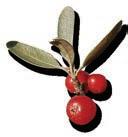
Mule Deer Survey
The North Dakota Game and Fish Department completed its annual mule deer survey, and results indicate western North Dakota’s mule deer population is 29% lower than last year and 5% below the long-term average.

Biologists counted 1,994 mule deer in about 286 square miles during this year’s survey. The overall mule deer density in the badlands was seven deer per square mile.
Bruce Stillings, Department big game management supervisor, said declines are due to effects from extreme winter conditions this year and historic blizzards from the previous spring that produced approximately 40 inches of snow with high winds and low temperatures.
Biologists had concerns with mule deer numbers heading into winter based on results from the fall survey. The fall survey is conducted to assess demographics of mule deer in the badlands. Buck to doe ratio and fawn production expressed as fawn to doe ratio are determined to evaluate population status and productivity of mule deer.
Biologists counted 1,116 mule deer in the aerial survey in October, which was 31% lower than 2021. The ratio of 69 fawns per 100 does was higher than 2021 (60/100) but well below the long-term average (87/100), while 40 bucks per 100 does was similar to 2021 (38/100) and the long-term (43/100).
The spring mule deer survey is used to assess mule deer abundance in the badlands. It is conducted after snow melt and before trees begin to leaf out, providing the best conditions for aerial observations of deer. Biologists have completed aerial surveys of the same 24 study areas since the 1950s.
The fall aerial survey, conducted specifically to study demographics, covers 24 study areas and about 306 square miles in western North Dakota. Biologists also survey the same study areas in spring of each year to determine deer abundance.
Hands Off Baby Animals
The North Dakota Game and Fish Department offers a simple message to the well-intentioned who want to pick up and rescue what appear to be orphaned baby animals this time of year: don’t touch them. Whether it is a young fawn, duckling, cottontail rabbit or a songbird, it is better to leave them alone.
Often, young animals are not abandoned or deserted, and the mother is probably nearby. Young wildlife are purposely secluded by adults to protect them from predators.
Anytime a young wild animal has human contact, its chance of survival decreases significantly. It’s illegal to take wild animals home, and captive animals later returned to the wild will struggle to survive without possessing learned survival skills.
The only time a baby animal should be picked up is if it is in an unnatural situation, such as a young songbird found on a doorstep. In that case, the young bird can be moved to the closest suitable habitat.
People should also steer clear of adult wildlife, such as deer or moose that might wander into urban areas. Crowding stresses animals and can lead to a potentially dangerous situation.
In addition, motorists are reminded to watch for deer along roadways. During the next several weeks young animals are dispersing from home ranges, and with deer more active during this time, the potential for car deer collisions increases.

Earth Day, Every Day
The North Dakota Game and Fish Department encourages students to design Earth Day patches to bring greater awareness to the environment in the state and elsewhere.

Yet, like Earth Day, which began in 1970 and kicked-started the environmental movement, the concern for our outdoor places isn’t simply a once-a-year-thing, but ongoing.
Understanding this, the Game and Fish Department supports
ND OUTDOORS ■ JUNE 2023 ■ 21
Earth Day, Every Day to promote continual awareness about the environment.
Anyone who participates in public land cleanup and improvement projects will receive the 2023 Earth Day Patch to recognize their service and celebrate Earth Day. Projects that qualify include refuse removal on local, state or federal property, and landscaping on public property such as planting trees, bushes and pollinator plants.
For more information, or to request patches for your group’s service project, contact Sherry Niesar, Earth Day coordinator, at 701-527-3714 or sniesar@nd.gov.
More Than a Challenge
CHALLENGE 2023
Last year the North Dakota Game and Fish Department introduced its Fish Challenge to encourage exploration of the state’s diverse fisheries and ultimately to recruit, retain and reactivate anglers with the boost of competition. More than 130 people submitted at least one fish in 2022, but what was more rewarding were the accompanying photos. The anglers weren’t covered head to toe in name brand fishing apparel in fancy boats, they weren’t just little kids, and none were holding a walleye. Rather, they were average people, many standing on shore, holding quality fish and all boasting a big smile brought to them from a day on the water in the pursuit of the challenge.
And while we succeeded in promoting the challenge to more than just kids, 7-year-old Rodney Schlafmann of Beulah was the first to complete the challenge.
We had enough positive participation and comments to bring the challenge back this year. We’re offering last year’s Classic Challenge (northern pike, yellow perch, smallmouth bass and channel catfish) to those who did not get a chance to complete it, but also a new Sportfish Challenge (bluegill, walleye, bass and trout). No matter which challenge anglers accept, the process is simple –snap a photo of each and submit your entry on the North Dakota Game and Fish website, gf.nd.gov, now through Aug. 15. Anglers who complete either challenge will receive a decal and certificate.
To our surprise, just days after announcing the Sportfish Challenge, Rodney submitted all four of his necessary fish, becoming the first angler, again, to complete the challenge
this year.
We met Rodney and his dad, Nolan, in May. While a little shy, we could tell how much Rodney loves to fish, but even more obvious was how much he loves spending time with his dad. And it’s safe to say the feeling was mutual. His dad told stories of Rodney’s first outings, how he had to learn how to cast to get last year’s coveted northern pike and how it was Rodney who got him back into the outdoors.
In fact, Rodney’s first fish came shortly after his dad bought a used portable fish house online. Rodney stated on the way that he’d like to catch a walleye, but his dad informed him there were unfortunately no walleye in Riverdale City Pond, but the young angler argued he wanted to catch one anyway. Shortly after setting up, the bobber went down and to both of their surprise, Rodney reeled in a 21-inch walleye. He was hooked, and he was now convinced anything is possible on the water.

Nolan went on to tell other stories of Rodney’s magic touch, like the time he picked out a green crankbait, his favorite color, and while trolling exclaimed he had a fish, but dad was not convinced. “That’s just the crankbait vibrating,” he said. Yet, when they reeled in to move spots, Rodney had a 17-inch walleye on his line.
Of course, Rodney and Nolan are just two anglers impacted by the Fish Challenge and it’s going to take a lot more to have a meaningful impact on fishing participation in the state, but we just can’t help but smile at the many years ahead for those two. Not only the countless fish Rodney will undoubtedly catch, but the priceless memories they’ll both have forever.
That stuff doesn’t happen indoors.
Check Fire Extinguishers in Boats
Boat owners should take note of a U.S. Coast Guard fire protection regulation.
Recreational boats with a disposable (non-rechargeable) fire extinguisher with a manufacture stamped date on the bottle that is older than 12 years are considered expired and must be removed from service. Fire extinguishers with a label stamped “Marine Type – USCG Approved” are considered up-to-date, and extinguishers without a date or marine label are most likely older than 2007 and must be replaced.
The following recreational boats are required to carry marine fire extinguishers:
• Boats with permanently installed fuel tanks.
• Spaces that are capable of trapping fumes, such as:
o Closed compartments, such as under seats.
o Double bottoms not sealed to the hull or not completely filled with flotation material.
o Closed living space.
o Closed stowage compartment where combustible or flammable materials are stowed.
WALLEYE BLUEGILL TROUT • BASS
NORTH DAKOTA GAME AND FISH
22 ■ ND OUTDOORS ■ JUNE 2023
Rodney Schlafmann tries his luck at a North Dakota fishery.
Game and Fish Pays Property Taxes
The North Dakota Game and Fish Department recently paid more than $729,000 in taxes to counties in which the Department owns or leases land. The 2022 in-lieu-of-tax payments are the same as property taxes paid by private landowners.


The Game and Fish Department manages more than 200,000 acres for wildlife habitat and public hunting in 51 counties. The Department does not own or manage land in Traill or Renville counties.
Following is a list of counties and the tax payments received.
The North Dakota Game and Fish Department’s enforcement division debuted a new boat this spring on the Missouri River. The boat used to patrol the Missouri is an upgrade from the previous boat employed by game wardens in that it features a drop-down bow that enables wardens to get on and off sandbars much easier. One of the other features is a marine night vision camera for search and rescue purposes. “Overall, it’s a sturdier boat,” said Jackie Lundstrom, Department operations supervisor. “This will be the boat that will help us improve our enforcement and help get the job done on the water.”
Don’t Miss an Episode!

Adams 188.88 Barnes 7,156.73 Benson 5,450.72 Billings 283.14 Bottineau 6,734.57 Bowman 2,410.45 Burke 1,039.71 Burleigh 26,938.28 Cass 8,108.37 Cavalier 14,957.59 Dickey 13,332.74 Divide 2,553.30 Dunn 5,283.76 Eddy 6,744.22 Emmons 7,576.85 Foster 1,062.48 Golden Valley 169.45 Grand Forks 20,460.43 Grant 1,218.15 Griggs 100.92 Hettinger 4,595.39 Kidder 12,673.84 LaMoure 11,823.72 Logan 419.22 McHenry 1,686.94 McIntosh 9,897.14 McKenzie 37,026.45 McLean 128,414.51 Mercer 21,489.12 Morton 25,618.49 Mountrail 6,438.72 Nelson 8,005.98 Oliver 2,825.03 Pembina 12,046.98 Pierce 3,327.71 Ramsey 17,160.43 Ransom 2,217.07 Richland 19,230.42 Rolette 54,942.69 Sargent 21,073.44 Sheridan 86,485.63 Sioux 221.60 Slope 1,948.20 Stark 5,646.82 Steele 10,947.41 Stutsman 5,688.19 Towner 2,501.88 Walsh 10,565.23 Ward 59.16 Wells 62,793.31 Williams 9,682.14
COUNTY TAX DUE COUNTY TAX DUE
Outdoors Podcast
get text or email reminders
time an episode launches.
Subscribe to the ND
to
each
ND OUTDOORS ■ JUNE 2023 ■ 23
CLEAN DRAIN DRY CLEAN DRAIN DRY
EVERY SURFACE. EVERY TIME. gf.nd.gov



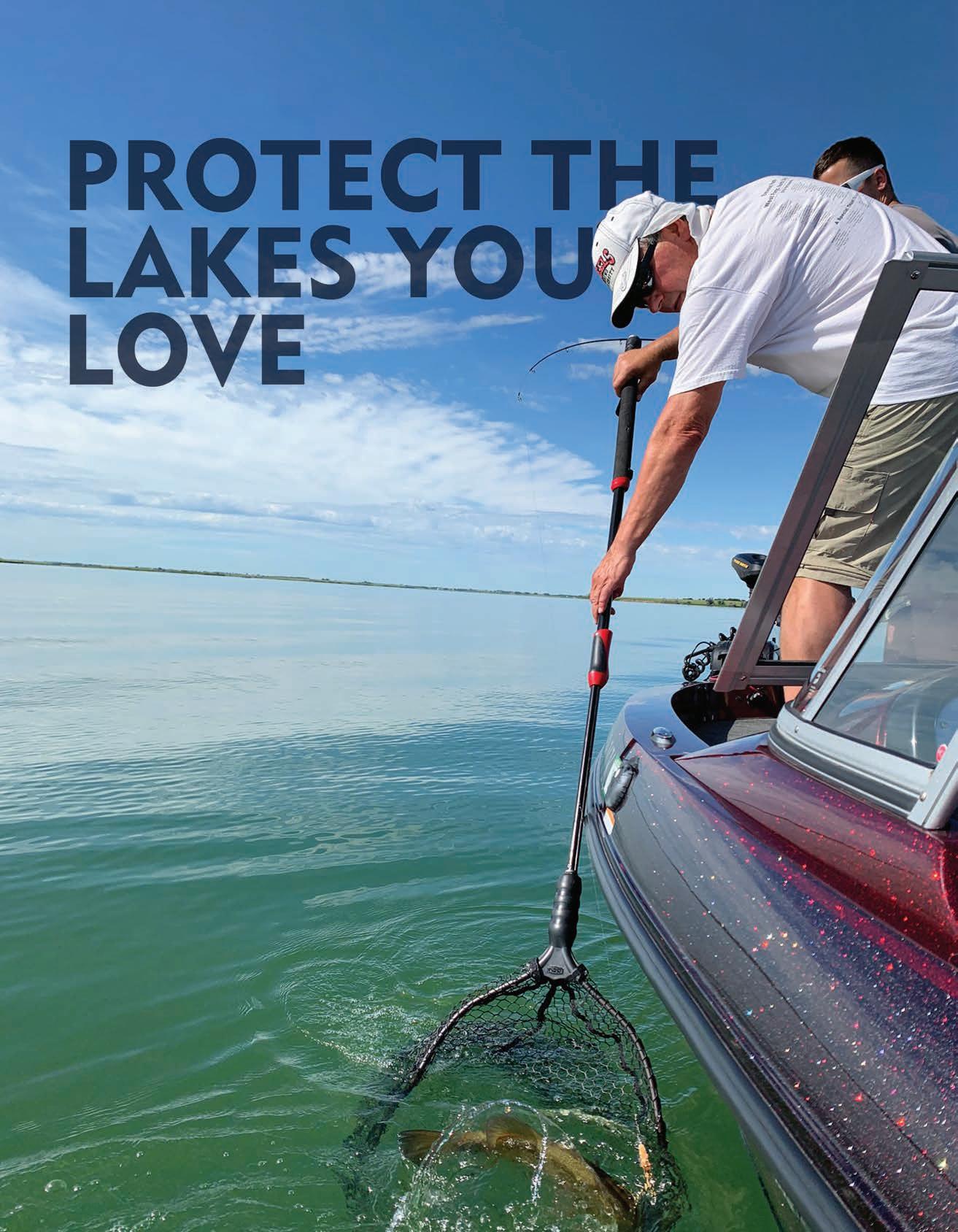
BACK CAST
Iwas an easy sell.
When my wife and youngest son, the latter being the hunter of the two who often wondered aloud when we were getting another bird dog, found a golden retriever puppy for sale in our price range, I was all in on pulling the trigger.

After putting our old and certainly beloved golden, Ollie, down in winter, I’d been trying to wrap my head around the trials of raising a puppy. I justified the undertaking, at least the potty-training part, by reasoning that I get up a couple times in the middle of the night anyway, so letting a puppy out would add little to my journey other than having to put on some shoes.
Turns out, after not having done the puppy thing for roughly 15 years, it’s been interesting how much I’d forgotten. And I certainly don’t remember being this tired back then.
No matter. We’re all in and the casualty list of chewed shoes, table legs, outdoor furniture cushions and the beheading of the occasional garden flower is shortish and hardly worth getting bent out of shape.
As I write this, Larry is 4 months old and change. If his dad and grandpa are good measuring sticks, Larry will be about 80 pounds fully grown. His big puppy paws lend some credence to that.
I’ve had a handful of bird dogs over the years and all of them I would describe as good. Certainly, my “good” differs from others, but I was certainly happy because they came when they were called, found the occasional bird and were cool to have around camp or home. Didn’t matter.
While Larry is a blank slate at this turn, months away from hunting season, I can say that his interest in the birds visiting our back yard at sunrise each morning while I drink coffee and scratch his ears is keen.
Then again, so is his interest in smashing and eating the ants and other bugs that make the fatal mistake of catching his attention on the concrete patio. If this somehow translates to flushing and retrieving upland game down the road, maybe we’ve got something.
By Ron Wilson
But I’m getting ahead of myself.
Larry will be just 8 months, still a pup, when the grouse season opens in early September. Like my Mom and Dad when they dropped me off for my first day of public school years ago, my expectations of Larry are not high.
Nor should they be.
I expect his early season grouse hunts to be a confusion of clickity, clackity grasshoppers, the occasional rabbit that he doesn’t stand a chance in catching and a myriad of new sounds and smells.
Just as long as he experiences all this embarrassment of newness in the same township I’m hunting in, we’ll be OK.

ND OUTDOORS ■ JUNE 2023 ■ 25
RON WILSON is editor of North Dakota OUTDOORS.
North Dakota Outdoors Magazine
North Dakota Game and Fish Department
100 N. Bismarck Expressway
Bismarck, ND 58501
To renew your subscription or change your address, call 701-328-6300 or go to gf.nd.gov/buy-apply.
gf.nd.gov/connect
Game and Fish Department
fisheries personnel got the walleye spawning process started on May 6 after a long winter and a delayed start to spring. According to Jerry Weigel, Department production/ development section supervisor, the egg take goal was 420 quarts of walleye eggs. That goal was easily surpassed as crews tallied 464 quarts, or roughly 56 million eggs. While the bulk of the eggs came from Lake Sakakawea fish, 107 quarts were collected at Devils Lake.
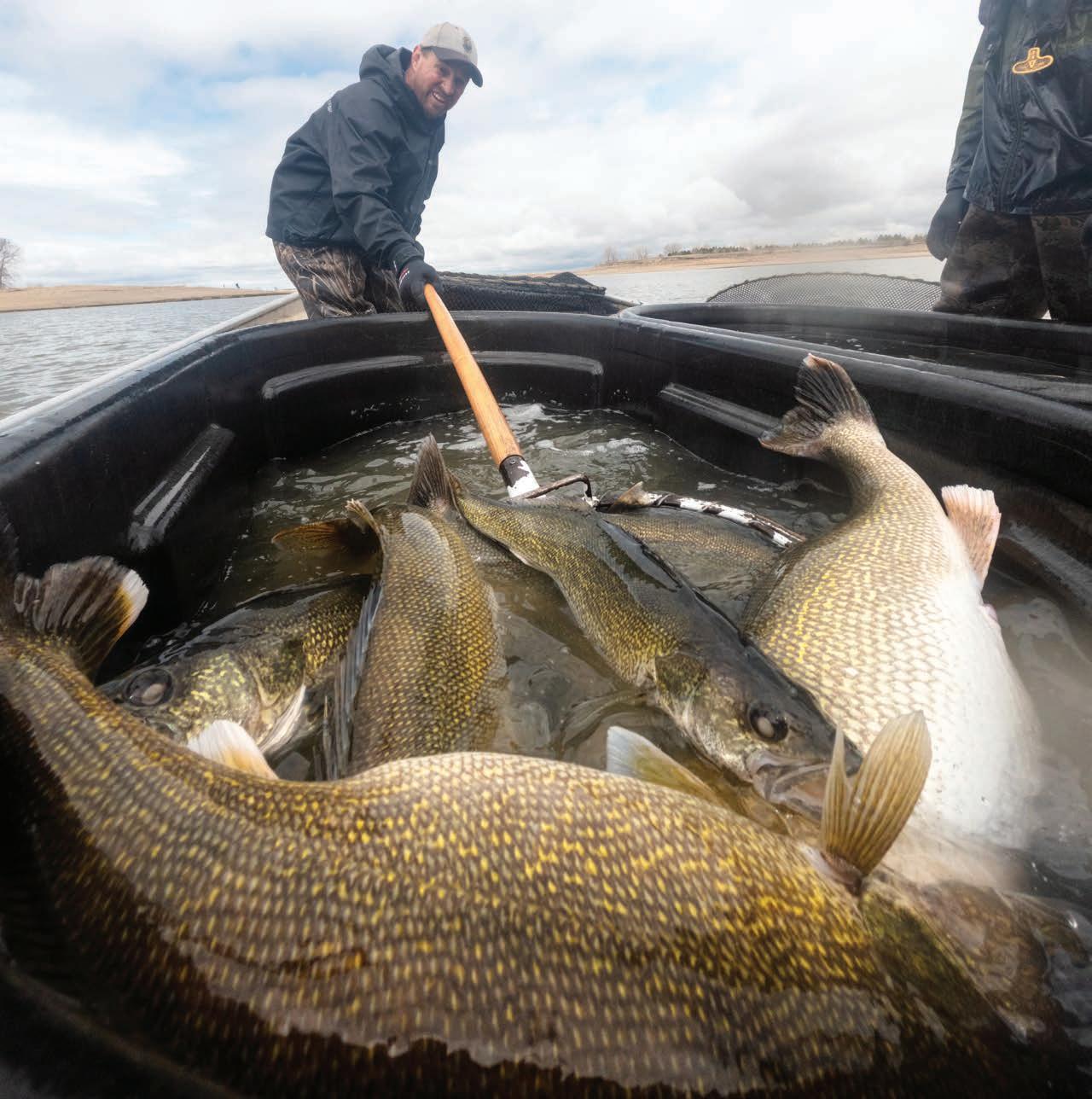
connect with us
ASHLEY PETERSON
PHOTO BY ASHLEY PETERSON






















 Jay Carlisle (left) and Kevin Ellison carefully remove an adult long-billed curlew from the 18-meter mist nest used to capture nesting birds.
Jay Carlisle (left) and Kevin Ellison carefully remove an adult long-billed curlew from the 18-meter mist nest used to capture nesting birds.



 By Ron Wilson
By Ron Wilson






















